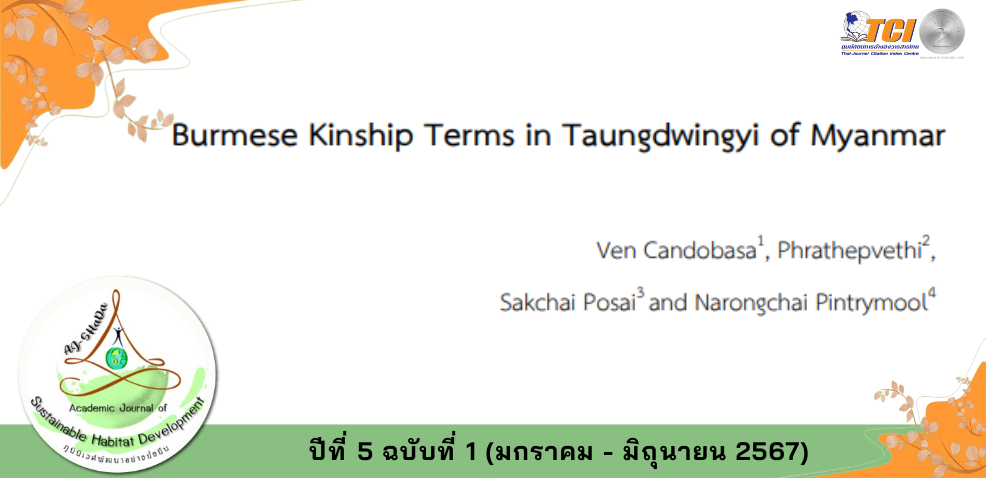Burmese Kinship Terms in Taungdwingyi of Myanmar
Main Article Content
บทคัดย่อ
The Objective of this research are: 1) To study the morphological variation of the Burmese kinship terms in Oh Gone and Yinn Thazi villages Taungdwingyi city of Myanmar, 2) To study the function of Burmese Kinship terms in Oh Gone and Yinn Thazi villages Taungdwingyi city of Myanmar. The research involved a target population of 278 people in Oh Gone and Yinn Thazi villages Taungdwingyi city of Myanmar, all of whom participated in the study. The study followed both quantitative and qualitative research methodology employing the questionnaire, in-depth interview, and additional comments collected from 278 respondents and it was analyzed by using SPSS version by means of frequency, percentage, mean, and standard deviation (S.D.). The Statistical Package for Social Science (SPSS) was utilized for the comprehensive examination of the collected data.
The result of research found as follows: The research was found that the linguistic differences and modifications in the expression of familial relationships, with a focus on understanding how specific kinship terms undergo morphological changes within the cultural and linguistic context of these two villages as stated that the investigation included 278 respondents, with 40.60% male and 59.40% female respondents. The age of respondents was divided into four categories, with 25.20% of respondents aged 25.20% being the majority. Regarding marital status, 34.50% were single, 21.90% married, with no respondents indicating divorce or other status. Overall, the majority of respondents were female, single, and married. In the quantitative analysis, it was observed that the majority of people used Burmese kinship terms in Taungdwingyi Myanmar, with high agreement levels on issues such as difficulty expressing ideas. The study sought to provide insights into the variations and nuances in the usage of familial language in different localities of Taungdwingyi city.
This research was focused on the understanding of role and significance of Burmese kinship terms within the cultural contexts of Oh Gone and Yinn Thazi villages in Taungdwingyi city, Myanmar. The study was explored how these terms function in shaping interpersonal relationships, societal structures, and cultural norms within these specific communities. The study aimed to uncover local perspectives and practices associated with Burmese kinship terminology, providing insights into the cultural intricacies that define familial bonds and social interactions in these villages.
Article Details

อนุญาตภายใต้เงื่อนไข Creative Commons Attribution-NonCommercial-NoDerivatives 4.0 International License.
เอกสารอ้างอิง
Bradley, David. (1993). Pronouns in Burmese-Lolo”, Linguistics of the Tibeto-Burman Area. Journal of Linguistics, 16(1), 140-152.
Burling, Robblns.(1965). Burmese kinship Terminology. Journal of Himalayan Linguistics, 19(3), 46-56.
Ding G-J, & Zhang S-Q. (2004). A Course Book of Cultural Linguistics [M]. Beijing: Educational Science Press.
Jianghua, Han. (2020). A Study of Kinship Terms in Thai from the Culture and Cognitive Perspectives. Macrolinguistics, 8(1), 125-138.
Ma Zan San Chiin. (2012). A study of Anthropological Perspectives on kinship systems practiced by chinpong (Uppu) National Living in Kanpetlet Township. (M.A research paper) University of Yangon Department of Anthropology, Chin State.
Norma Pawestri. (2020). Comparatives Study of Kinship Terms in Thai, Vietnamese and Indonesian Language. Language Center, International Relations Department, Faculty of Humanities, Bina Nusantara University, Jakarta, Indonesia. Journal of Community Development Research, 13(4), 38-46.
Pimrat, Lalita, (2022). The Analysis of Khmer Kinship Terms in Buri Ram Province, (Ph.D. Dissertation). Mahachulalongkornrajavidyalaya University, Phra Nakhon Si Ayutthaya Province.
Rosalie Stolz.(2021). Living Kinship, Fearing Spirits Sociality among the Khmu of Northern Laos. ASIEN the German Journal on Contemporary Asai. 160(161), 251–253
Soma, Ven, (2020). A Phonological study of southern Burmese language spoken in Mon state of Myanmar. (M.A. Thesis). Mahachulalongkornrajavidyalaya University, Phra Nakhon Si Ayutthaya Province.
Shu, H., G. Edwards & C. Qi. (2013). Cognitive Distance, Proceedings of SPIE. The International Society for Optical Engineering [C].
Tang, Q-H. & W-C. Rama. (2019). Physical Practice and Cultural Metaphors: Based on the investigation of the Bimo and Suni of Yi people in Liangshan [J]. Social Science Research, (4), 118-123.


